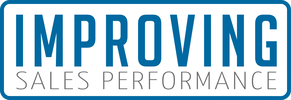 There's a quote from one writer that goes like this: "Don't chase success. Decide to make a difference and success will find you." Even though that concept could be applied to many aspects of life, let's look at it from the viewpoint of sales success in your organization. It's true that everyone in the sales industry wants that "big win," that easy fix to their performance issues that makes everything fall neatly into place. There's nothing wrong with that feeling. It's only natural. Here's the thing, though. Chasing that big win is usually counterproductive. In real life, it almost always takes a series of small, deliberate actions to get to a place where your business is humming along. It takes cooperation and collaboration. It takes hard work and perseverance. It takes intentionality and planning. Here's another saying (or part of a saying) that makes the point well: Your actions become your habits. Your habits become your values. Your values become your destiny. What Sales Success Stories Have in Common The point is, business growth is the result of small, intentional actions and good habits. These form the foundation of your brand's values and reputation. And ultimately, they decide your organization's destiny. Sales success stories may be flashy, or dramatic, or even heartwarming. But if you dig a little deeper, you'll almost always find that all success stories have a few things in common: namely, 3 solid frameworks that enable a sales organization to perform at a high level. Let's talk about each one of these frameworks, and why they are so crucial to improved sales performance. Framework #1: The Revenue Equation The Revenue Equation framework is actually a combination of three critical factors that form the basis of your entire sales process. These three factors are:
When each of these factors are streamlined and optimized, the result will be revenue stabilization and growth. The question is, what do these elements involve, and how do they work together? Sales Foundations (Who Are You?) Your sales foundations are the values and characteristics that make your brand unique. Sales foundations include your company's reputation, your pricing strategy, and your unique selling proposition (USP). Think of Apple, Inc. as an example. They have a reputation as a leader in technological innovation. Their price points reflect their position as a premier brand, and one of their USPs is their commitment to personal privacy and security. As the name implies, your sales foundations form the basis of everything else you do within the sales process. That's why you absolutely must understand who you are as a company, and then play to those strengths. Sales Design (Who Do You Sell To?) Once your sales foundations have been firmly established, you need to understand who your target customers are. After all, you don't want to be "punching air" by targeting consumers that aren't likely to purchase from your business. This is where buyer personas come into the picture. Your marketing team (preferably with input from sales) needs to come up with a profile of your ideal customer — or even multiple profiles, depending on how specific your targeting is. With that buyer persona in hand, your sales reps will be in a better position to understand the thoughts, concerns, and desires of their leads, nurture them effectively, and eventually convert them into paying customers. Sales Infrastructure (How Will You Sell It?) Once you have a firm grasp on who you are, and who your ideal customer is, it's time to build your sales infrastructure. In other words, the processes that can bridge the gap between you and your consumers. Your infrastructure includes the systems and software programs you use to manage customer relationships, your clearly defined sales funnel, as well as your KPIs, metrics and quotas. When these three elements — sales foundations, sales design, and sales infrastructure — are all working properly, and are clearly aligned with one another, then your first framework (The Revenue Equation) is firmly in place. Framework #2: The Individual Performance Planner Your Revenue Equation is in place. Everyone on your team has collaborated to make it a reality. Now, you have to start shifting your focus from the big picture to the details. These details are comprehensive, from the Revenue Equation to the individual performance of your sales reps. This is where collaboration and open communication become even more critical. Within this framework, your first order of business is to discuss with each sales rep what his or her strengths and growth opportunities are. What short-term and long-term goals will the rep set inside (and possibly outside) of work? The outcome of these discussions will be condensed and solidified into their own Individual Performance Planner. Intentionality is key in this framework. You have to demonstrate how serious you are when it comes to supporting your team members, and helping them achieve their goals. At the same time, your reps have to buy into this process, and commit to being the best salespeople they can be. This give and take is the only way to achieve maximum value from the important (but still theoretical) Revenue Equation. Framework #3: The Revenue Planner This final framework is where you'll see the fruits of your labor. You have your Revenue Equation in place, and your team members onboard. Now you have the insights and the freedom to identify key growth opportunities within the sales process. Next, you'll develop a plan of action for each one. Over the first three months of the process, this will involve taking various actions. Consider adjusting discounts to featured products, doubling down on relationships with established customers, or refining your price points. Really, the sky's the limit. After achieving some quick wins, you'll want to stabilize your revenue in the following three months. Aim for continuous revenue growth in the months (and years) to follow. While the Revenue Planning stage is unique to each business, the framework it provides is useful across the board. Create Your Own Success Story Look deeply at sales success stories. Odds are you'll discern these three frameworks at work, in one way or another. Build your sales process around these frameworks. Then, your company will also enjoy quick wins and sustainable growth. If you'd like more insights on how to improve sales performance for your SMB, sign up for our newsletter. Contact us directly, or explore our website for other valuable resources and webinars. Comments are closed.
|
Meet Me
Archives
April 2024
Categories
All
|
|
We are headquartered in Colorado with domestic and international teammates and clients. Please use the contact form on this page to inquire about any of our books, podcasts appearances, speaking engagements and workshops, any of our offerings, or simply to connect.
|
© Improving Sales Performance. All Rights Reserved.


 RSS Feed
RSS Feed
